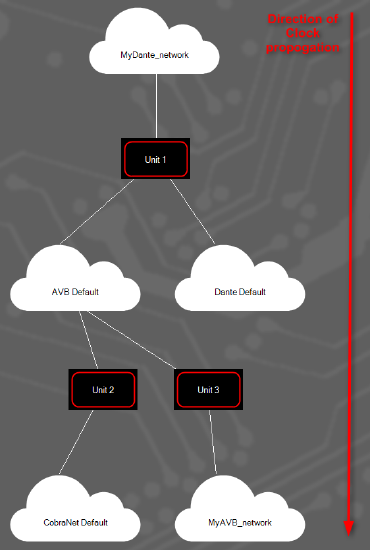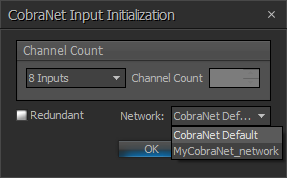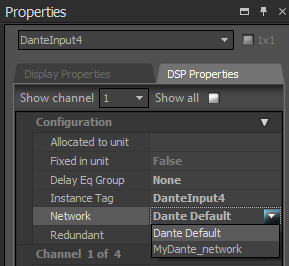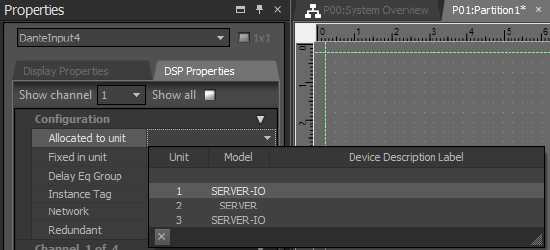Using multiple media networks and audio protocols
A notable feature of the Tesira platform is the ability to combine and synchronize audio from AVB, Dante, and CobraNet sources in a single system, even a single device. The software supports several features for enhanced audio networking, providing greater flexibility for the design and installation of both single and multi-protocol systems.
In brief:
- A Tesira system can support multiple AVB, CobraNet, and Dante networks.
- An external media network (i.e., CobraNet, Dante, or 3rd-party AVB) can be assigned at the system's Clock Master, allowing a Tesira system to synchronize to a 3rd-party device or system.
- Multiple Tesira systems can more easily and flexibly share common network infrastructure.
Note: TesiraFORTÉ devices only feature one form of digital audio transport protocol, AVB or Dante as defined in their part name. These units can be expanded to include AVB or Dante with the addition of TC-5D or TesiraFORTÉ X which natively support both protocols for use within a single device or system.
Overview
Use of these features is optional. The Tesira software is already pre-configured for one AVB, one Dante, and one CobraNet network, so this document is important only when additional audio networks are required, or if a change to clock propagation is required.
The basic steps for adding and working with media networks are:
- Configure the media networks
- Select the network on which the master clock will be located
- Assign I/O clocks to these networks
Media network configuration
AVB, Dante and CobraNet input/output blocks can be assigned to one of the system’s named networks, allowing AVB streams, Dante flows, and CobraNet bundles to be associated with a specific media network. One network is selected as the clock master for the Tesira system, regardless of protocol.
Select Clock Master Network
The Tesira system must derive its Media Clock from one of the available networks as selected. Checking the Clock Master box tells the Tesira system on which network the master clock is located. The Tesira system will look look for the master/leader clock device on this network, negotiate master/leader role accordingly and then synchronize. Synchronization clocking will propagate downward to the other media networks.
In other words, the Tesira system will be a clock follower/slave or leader/master on the Clock Master media network, and it will subsequently be the clock leader/master on the other media networks.
Figure 1 - Media Networks Setup, default settings
Considerations:
-
When Dante is involved, consideration must be given to what other devices are or will be on the shared Dante network. Some Dante devices such as Shure MXW or Yamaha mixing consoles may require they be the Dante Leader (with an external media clock) on the shared Dante network. If this is part of the design or a future possibility that such device may be introduced to the Dante network, it is often wise to configure the Tesira system to derive its clock from the shared Dante network.
Network diagrams
The Media Networks of a system can be viewed as a tree which has the Clock Master media network at its root. Media network connections which lead toward the Clock Master are “upstream” connections, and those which lead away from it are “downstream” connections. A media clock is propagated from “upstream” to “downstream” connections.
To help make the connections easy to understand, a Tesira System’s media network tree can be viewed in the new Media Networks Diagram window. Select the System menu, then Media Network, then Diagram.
Here is an example, annotated to show the direction of media clock propagation:
Figure 6 - Media Networks Diagram, example system
Adding and managing Media Networks
Tesira automatically creates a default network of each type, and media network input/output blocks will be automatically assigned to their corresponding default network. User-defined media networks can be added. To add new media networks, and assign the system's Clock Master network, select the System menu, then select Media Network then Setup. This will open the Media Networks Setup dialog.
The three default networks cannot be deleted, but the Clock Master can be selected, and the reporting of clock synchronization faults can be disabled on the default Dante and CobraNet networks.
By default, the dialog will look like this:
Media Networks Setup, default settings
To add new networks, click the Add button. Select the desired Network Type, and edit the name if required. Any of the networks can be assigned as the system's Clock Master.
Figure 2 - Media Networks Setup, additional media networks
Assigning I/O blocks to a network
When adding an AVB, Dante or CobraNet input or output block to a configuration, a named network of the corresponding type can be chosen from the drop-down list in the initialization dialog box. Here is an example:
Figure 3 - Input/output Initialization dialog
After initialization, the selected Network can be changed in one of two ways. One method is to right-click on the block then select Edit Block Parameters.
The other method to change network assignment is to select the block then open the DSP Properties tab of the Properties window. The network assignment can be changed in the Network field. Here is an example of this method:
Figure 4 - input/output block network assignment
Assigning blocks to a device
AVB, Dante or CobraNet blocks can be assigned to a specific device in the same way as any other input/output or DSP blocks. In the DSP Properties tab of the Properties window, in the Allocated to Unit field, select the correct device.
To lock this assignment, and prevent the compiler from over-writing it, set Fixed in Unit to TRUE.
Figure 5 - input/output block device assignment
Essential rules
General network & clock rules
- A system of Tesira devices can support only a single media clock domain, i.e. Tesira devices must be synchronized to the same clock source to share digital audio over a media network.
- In a multi-device system, all Tesira devices with an AVB, Dante, or CobraNet media interface must have at least one network media connection which can be traced back to the Clock Master media network. Consequently:
- A system cannot contain unconnected sub-groups, i.e. clock 'islands' (groups which share media connections with each other but not with the rest of the system).
- Separated groups of Dante-only devices and AVB-only devices are not supported within a single Tesira configuration file.
- The exception to this is non-networked devices, e.g. TesiraFORTÉ units without AVB or Dante. These may be included in the same file as media networked devices.
- Up to three layers of media networks are supported. For examples, see the Tesira help page: Media Clock Topologies.
Implicit AVB
- Implicit AVB connections (connections between Tesira devices, created by the compiler and represented by blue dotted lines in Tesira software) are made on the AVB Default network only.
- Tesira Expanders must use implicit AVB connections. Therefore, the Input/Output blocks for audio expanders will be automatically assigned to the AVB Default network.
- Because of 1 and 2 above, any system which contains audio expanders or uses implicit AVB connections must use the AVB Default network.
- 1722.1 compatible AVB blocks can be used on both the AVB Default network and user-defined AVB networks.
CobraNet, Dante & AVB
- SERVERs are fitted with one AVB card by default and have one user-configurable slot which can be fitted with any Tesira option card, including a Dante or CobraNet card, or a second AVB card.
- SERVER-IO devices have three configurable slots which can be fitted with media networking option cards, with a supported maximum for each type of card of: 1 x AVB; 2 x Dante; 2 x CobraNet.
- Implementing a second AVB network in a Tesira system requires a Tesira device with two AVB cards installed, one to connect to the AVB Default network and one to connect to the user-defined AVB network. Only SERVERs support two AVB cards.
- TesiraFORTÉ devices are available with AVB and Dante interfaces only.
- TC-5D can be used to bridge AVB and Dante networks as this device is AVB and Dante capable when used with another Tesira AVB or Dante server class device.
- Forte-X is also capable of AVB and Dante as a single device or part of a larger Tesira system.
Clock Propagation
- Clock propagation between Tesira devices on the AVB Default network is managed automatically by the compiler. The compiler will automatically set each CobraNet card's conductor priority and each Dante card's Sync to external and Preferred Master flags to ensure that clock propagation on the network matches the Media Networks Diagram.
- A system of Tesira devices may be synchronized to an external, 3rd party device on the selected Clock Master network.
- A Tesira system can be synchronized to a 3rd party AVB device by placing an AVB input block on the Clock Master AVB. An AVB controller, such as Riedel AVB Manager, must be used to configure the Tesira system to synchronize to an incoming AVB stream.
- A Tesira system can be synchronized to a 3rd party Dante or CobraNet device by placing the Dante/CobraNet input block on the network assigned as the Clock Master. The Tesira system will synchronize automatically.
- A Tesira system can be synchronized to a 3rd party AVB device by placing an AVB input block on the Clock Master AVB. An AVB controller, such as Riedel AVB Manager, must be used to configure the Tesira system to synchronize to an incoming AVB stream.
- Any media network (AVB, CobraNet or Dante) can have only one master clock source. If N Tesira systems are connected to the same Dante/CobraNet network, then that network must be the clock source network for at least N-1 of the connected Tesira systems.
For example, if two or more Tesira systems share a common Dante network:- The Dante network can be the master clock for all Tesira systems, or
- The Dante network can derive its master media clock from one of the Tesira systems, but it must then be the master media clock for all other connected Tesira systems.
Legacy Tesira system behavior when sharing a common network
FW 2.3 & earlier
In Tesira versions 2.3 and earlier, the rule was simple: Tesira devices which discovered each other on the control network would assume they were connected to the same AVB media network and attempt to synchronize with each other.
In installations of multiple Tesira systems, which shared a common control network but not a common AVB media network, this could result in a synchronization failure in one or more of the Tesira systems.
FW 2.4 & newer
In Tesira version 2.4 the rule has been changed, making it easier to work with larger and more complex installations:
Only Tesira devices in the same system will assume they are part of the same AVB media network and try to synchronize with each other.
A single Tesira configuration file defines a single media clock domain. Tesira devices programmed in same file will attempt to synchronize with each other; Tesira device programmed in separate files will not try to synchronize with each other.







